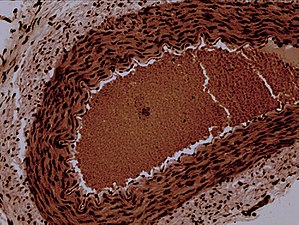Arteriole
| Arteriole | |
|---|---|
 Types of blood vessels, including an arteriole and artery, as well as capillaries. | |
 Rabbit arteriole at 100X | |
| Details | |
| Pronunciation | /ɑːrˈtɪəri.oʊl/ |
| Identifiers | |
| Latin | arteriola |
| MeSH | D001160 |
| TA98 | A12.0.00.005 |
| TA2 | 3900 |
| FMA | 63182 |
| Anatomical terminology | |
An arteriole is a small-diameter blood vessel in the microcirculation that extends and branches out from an artery and leads to capillaries.[1]
Arterioles have
Structure
Microanatomy
In a healthy vascular system the
Physiology
Blood pressure
The up and down fluctuation of the
The decreased velocity of flow in the capillaries increases the blood pressure, due to
Autoregulation
Arteriole diameter varies according to autoregulation of organs or tissues to maintain sufficient blood flow despite changes in pressure via metabolic or myogenic factors which include stretch, carbon dioxide, and oxygen among other factors.[4] Generally, norepinephrine and epinephrine (hormones produced by sympathetic nerves and the adrenal gland medulla) are vasoconstrictive acting on alpha 1-adrenergic receptors. However, the arterioles of skeletal muscle, cardiac muscle, and pulmonary circulation vasodilate in response to these hormones when they act on beta-adrenergic receptors. Generally, stretch and high oxygen tension increase tone, and carbon dioxide and low pH promote vasodilation. Pulmonary arterioles are a noteworthy exception as they vasodilate in response to high oxygen. Brain arterioles are particularly sensitive to pH with reduced pH promoting vasodilation. A number of hormones influence arteriole tone such as angiotensin II (vasoconstrictive), endothelin (vasoconstrictive), bradykinin (vasodilation), atrial natriuretic peptide (vasodilation), and prostacyclin (vasodilation).
Clinical significance
Arteriole diameters decrease with age and with exposure to air pollution.[5] [6]
Disease

Any pathology which constricts blood flow, such as stenosis, will increase total peripheral resistance and lead to hypertension.
Arteriosclerosis
Arteriolosclerosis is the term specifically used for the hardening of arteriole walls. This can be due to decreased elastic production from fibrinogen, associated with ageing, or hypertension or pathological conditions such as atherosclerosis.
